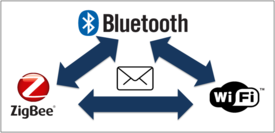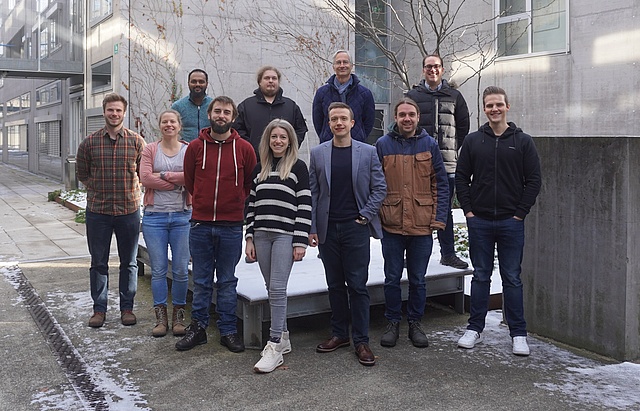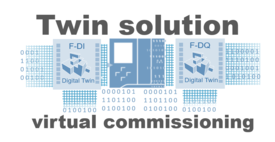"Low-power Embedded Networked Systems" Group
The Low-power Embedded Networked Systems (LENS) group is a team of researchers focusing on future connected wireless embedded systems, aiming to make them more dependable and sustainable. The team's activities can be broadly characterized as "systems and application-driven experimental research" at the intersection of wireless networking, embedded systems, and IoT applications. Among others, the group works on the design principles, optimization methods, and tools necessary to network resource-constrained wireless devices -- which are the basis for the Internet of Things -- in a reliable yet energy-efficient manner.
In the few years since its foundation (2016), the LENS group, led by Assoc.Prof. Dr. Carlo Alberto Boano, has distinguished itself internationally for the scientific excellence of its research on low-power wireless networks and IoT research. More than 25 papers have been published at leading/excellent conferences (i.e., rated CORE A/A*) and more than 20 awards have been received (including numerous best paper/demo/poster/artifact awards). The group has supervised 6 successful PhD theses and over 40 Master's and Bachelor's theses; in total, more than 100 scientific contributions have been published (full list), many of them in collaboration with academic and industrial partners. The research results of the LENS group led to patents as well as to the foundation of a company (DEWINE Labs GmbH) by former group members. Moreover, the group has been involved in several third-party funded national, European, and international projects, and is also internationally renowned for its open benchmarking infrastructures (such as D-Cube), which have been used to organize competitions quantitatively comparing the performance of state-of-the-art low-power wireless systems.
Exemplary research challenges tackled within the group include:
- dependable communication despite harsh environmental conditions;
- energy-efficient operations towards zero-power and sustainable IoT systems;
- development of testbeds and tools for a quantitative benchmarking;
- robust and scalable ultra-wideband localization and communication;
- detection and mitigation of radio interference as well as jamming attacks;
- cross-technology communication, coordination, and synchronization;
- low-latency communication in the mesh-cloud continuum;
- highly-performant and fault-tolerant wireless mesh networks.
Third-party funded research projects
Description: The overarching goal of TRANSACT is to develop a universal distributed solution architecture for the transformation of safety-critical cyber-physical systems from local, stand-alone systems into safe and secure distributed solutions. Our research focuses on methods and techniques to analyze and sustain the required end-to-end performance of distributed applications, which involves the prediction of device/edge/cloud workload patterns and the suitability of different protocol configurations to sustain a given end-to-end performance.
Involved researchers:
Cooperation partners: The activities of the SPiDR project are carried out in close cooperation with the SSRC team of the Technology Innovation Institute.
Description: SPiDR brings together the latest advances in wireless networking, localization, benchmarking, collaborative awareness, and machine learning, towards the development of secure, resilient, and highly-performant wireless mesh networks. Within SPiDR, we will create benchmarking infrastructures supporting experimentation on wireless networks based on Wi-Fi, Bluetooth Low Energy (BLE), and Ultra-wideband (UWB) technology; we will design dependable and scalable networking protocols that are resilient to malicious agents; we will provide autonomous entities such as drones with RF context- and location-awareness, as well as with the ability to identify and mitigate security threats, network anomalies, and coexistence issues.
Involved researchers:
Description: The ENHANCE-UWB project aims to develop a testbed allowing for the reproducible study of UWB transmissions in complex application environments. The developed testbed should also allow benchmarking of communication performance in the presence of co-located wireless devices sharing the same spectrum, and allow experimentation of non-line-of-sight conditions.
Involved researchers:
Description: Electronics-based systems (EBS) are becoming more and more prevalent in production, infrastructure and transport, but are only accepted if people trust these systems. Reliability is therefore becoming the cornerstone for the social acceptance of electronics-based systems. The researchers in the doctoral programme Dependable ElectroNIc-Based SystEms (DENISE) will explore concepts, methods and application-oriented tools to make EBS more reliable. The project deepens the very good relationship between FH Joanneum and Graz University of Technology through a joint doctoral programme. DENISE creates an integrated research framework across disciplinary boundaries and links reliability concepts of sensors with networked embedded devices. Existing strengths will be built upon and by pooling complementary expertise DENISE will lead to sustainable progress in the EBS sector.
Involved researchers:
Internal strategic projects
Description: Recently, ultra-wideband (UWB) technology has gained increasing attention in both industry and academia thanks to its superior time-domain resolution. UWB has indeed become one of the most popular choices for developing indoor positioning systems, with applications ranging from the automotive sector (e.g., secure vehicle access) and industrial domain (e.g., asset tracking) to smart healthcare (e.g., assisted living, medical monitoring) and other IoT use cases.
Our group has been among the first exploring research aspects at the intersection of networking and positioning on off-the-shelf UWB hardware, including: (i) runtime adaptation of PHY and MAC layer settings, (ii) single-anchor localization, (iii) concurrent ranging, (iv) scalable TDOA systems exploiting quasi-simultaneous transmissions, (v) secure ranging, (vi) NLOS detection and mitigation, as well as (vii) robustness to Wi-Fi 6E interference.
Several of these activities have been carried out in the context of the "DependableThings" LEAD project at TU Graz, which carried out cutting-edge basic research aiming to offer methods and tools to predict, guarantee, and ultimately raise the level of dependability of the IoT. Within this project, coordinated by Prof. Römer, our group is involved in the "dependable wireless communication and localization" sub-project.
Selected publications (see full list here):
- Understanding and Mitigating the Impact of Wi-Fi 6E Interference on Ultra-Wideband Communications and Ranging, IPSN'22
- Performance of Support Vector Regression in Correcting UWB Ranging Measurements under LOS/NLOS Conditions, CPS-IoTBench'21
- Towards Secure and Scalable UWB-based Positioning Systems, IEEE MASS'20
- SnapLoc: An Ultra-Fast UWB-Based Indoor Localization System for an Unlimited Number of Tags, IPSN'19
- SALMA: UWB-based Single-Anchor Localization System using Multipath Assistance, ACM SenSys'18
- Enabling Runtime Adaptation of Physical Layer Settings for Dependable UWB Communications, IEEE WoWMoM'18
Involved researchers:
Cooperation partners: Some of our tools used to benchmark the performance of IoT protocols, such as JamLab-NG, have been designed together with colleagues at SEEMOO @TU Darmstadt.
Description: D-Cube is a full-fledged benchmarking infrastructure that provides a consistent way to evaluate the performance of low-power wireless systems. Hosted at the Institute of Technical Informatics of Graz University of Technology, D-Cube supports the automated testing of the reliability, timeliness, and energy consumption of low-power wireless communication protocols in a variety of settings. The primary audience of D-Cube are academic researchers and industry practitioners creating low-power wireless networking solutions that would like to quantitatively assess and compare their performance with that of other systems addressing the same class of applications.
D-Cube currently supports two popular hardware platforms: the TelosB (Tmote Sky) mote and the Nordic Semiconductors nRF52840. Hence, D-Cube enables the benchmarking of solutions based on IEEE 802.15.4 and Bluetooth Low Energy technology. With about 50 nodes for each available platform and the ability to generate harsh RF conditions, D-Cube is well-suited for testing the performance of mesh networking and multi-hop solutions in the presence of radio interference. D-Cube's Webpage: link.
Selected publications (see full list here):
- Making D-Cube an Open Low-Power Wireless Networking Benchmark, EWSN'20
- Towards an Automated Monitoring of RF Activity in Low-Power Wireless Testbeds, CPS-IoTBench'20
- JamLab-NG: Benchmarking Low-Power Wireless Protocols under Controllable and Repeatable Wi-Fi Interference, EWSN'19
- Moving Beyond Competitions: Extending D-Cube to Seamlessly Benchmark Low-Power Wireless Systems, CPSBench'18
- A Competition to Push the Dependability of Low-Power Wireless Protocols to the Edge, EWSN'17
Involved researchers:

Towards zero-power and sustainable IoT systems
Time window: 2021 - Present
Type: Strategic project funded by ITI
Description: For more than two decades, the wireless sensing and networking community has worked relentlessly in order to enable the design of long-lasting networked embedded systems across many application domains. Despite remarkable progress, sustainable long-term wireless sensing and networking remains a far-fetched goal because most systems rely on batteries and a stable power source. Our research aims to provide new tools and solutions to support the creation of long-lasting zero-power networked embedded systems harvesting energy from the surrounding environment.
Selected publications (see full list here):
- Leakage-Aware Lifetime Estimation of Battery-Free Sensor Nodes powered by Supercapacitors, ENSSys'22.
Involved researchers:

Improving the reliability and applicability of LoRa-based systems
Time window: 2016 - Present
Type: Strategic project funded by ITI and by the CETC Europa Innovation Industry & Technology GmbH
Cooperation partners: Some of our activities aimed at improving the reliability and applicability of LoRa-based systems have been carried out with colleagues at the Shanghai Advanced Research Institute (SARI).
Description: Research on LoRa technology has surged in the last decade, fuelled by its growing popularity. The community has relentlessly worked on increasing scalability, energy efficiency, and reliability, for example, by means of better coding schemes for data recovery, enhanced link quality estimation techniques, as well as refined parametrization of physical layer settings. Researchers have also derived mechanisms to increase data throughput (e.g., by leveraging concurrent transmissions), and have investigated how to establish a communication with devices employing other technologies by means of cross-technology communication, so to enable new use cases and push the applicability of LoRa even further. In our research, we aim to outstretch this body of literature with solutions that can further increase the reliability of LoRa-based systems (e.g., to temperature fluctuations) and simplify testing by means of an infrastructure-Less LoRa testbed (ChirpBox). We further aim to boost the data throughput of LoRa-based systems while decreasing their overall energy consumption, as well as to enable new use cases that can expand the applicability of LoRa technology.
Selected publications (see full list here):
- EMU: Increasing the Performance and Applicability of LoRa through Chirp Emulation, Snipping, and Multiplexing, IPSN'22
- ChirpBox: An Infrastructure-Less LoRa Testbed, EWSN'21
- Impact of Temperature Variations on the Reliability of LoRa: An Experimental Evaluation, SENSORNETS'18
- An Experimental Evaluation of the Reliability of LoRa Long-Range Low-Power Wireless Communication, JSAN'17
Involved researchers:

Cross-technology communication, synchronization, and coordination for the Internet of Things
Time window: 2016 - 2021
Type: Strategic project funded by ITI, by the Austria Wirtschaftsservice (AWS), by the European Commission under the H2020 program, by the FFG, and by the FFG-funded Pro2Future COMET Center
Cooperation partners: We carry out our cross-technology communication research also with colleagues at SEEMOO @TU Darmstadt and at the School of Software @Tsinghua University.
Description: Cross-technology communication (CTC) has emerged as a suitable alternative to enable a direct data exchange among wireless devices with incompatible physical layer without the need of multi-radio gateways. In our research, we aim to: (i) improve software support for CTC through the X-Burst framework, (ii) devise new low-power protocols guaranteeing cross-technology neighbour discovery and rendezvous, (iii) enable a microsecond-level clock synchronization across devices employing heterogeneous wireless technologies, as well as to (iv) enable coordination among coexisting wireless devices.
Selected publications (see full list here):
- X-Sync: Cross-Technology Clock Synchronization Among Off-The-Shelf Wireless IoT Devices, IEEE LCN'21.
- Leveraging Cross-Technology Broadcast Communication to build Gateway-Free Smart Homes, DCOSS'21.
- SERVOUS: Cross-Technology Neighbour Discovery and Rendezvous for Low-Power Wireless Devices, EWSN'21.
- BiCord: Bidirectional Coordination among Coexisting Wireless Devices, IEEE ICDCS'21
- X-Burst: Enabling Multi-Platform Cross-Technology Communication between Constrained IoT Devices, IEEE SECON'19
Involved researchers:

Enabling Time-Critical Internet of Things Applications based on Bluetooth Low Energy
Time window: 2016 - 2022
Type: Strategic project funded by ITI
Description: The growing popularity of Bluetooth Low Energy (BLE) technology results in more and more BLE devices being used in time- and safety-critical IoT applications, such as industrial control systems or safety-critical healthcare applications. In these applications, BLE devices need to communicate with other IoT devices within given end-to-end reliability and latency bounds while operating on a tight energy budget for an extended period of time. Unfortunately, BLE devices employed in real-world settings are likely to experience unpredictable packet loss and delay caused by external interference from co-located radio devices, narrow-band fading effects, or effects on the path across the Internet. In our research we study how BLE devices can meet given end-to-end reliability requirements, such as a maximum delay or a minimum reliability, in order to enable even the most constrained BLE devices to reliably exchange time-critical data with peer devices.
Selected publications (see full list here):
- Ensuring End-to-End Dependability Requirements in Cloud-based Bluetooth Low Energy Applications, EWSN'21.
- Improving the Reliability of Bluetooth Low Energy Connections, EWSN'20.
- Improving the Timeliness of Bluetooth Low Energy in Dynamic RF Environments, ACM TIOT'20.
- Performance and Trade-offs of the new PHY Modes of BLE 5, PERSIST-IoT'19
- BLEach: Exploiting the Full Potential of IPv6 over BLE in Constrained Embedded IoT Devices, ACM SenSys'17
Involved researchers:
- We are looking for talented PhD students / Postdoc researchers with solid experience on our research topics that are interested in joining our group: if you want to shape the future of embedded wireless IoT systems, and make them more dependable, contact us!
- 06.02.2025: Markus Schuss gave a lecture on testbed experimentation and benchmarking at the 1st European Mobile Systems Winter School: 'Hands-on AI and Mobile Systems: Research and Practice' in Como!
- 03.02.2025: The APEX framework created by H. Hydher has now been open-sourced to the community!
- 30.01.2025: Ahmed Ahmed has successfully defended his MSc thesis entitled "Enabling Dependable BLE Applications Involving Android- and iOS-Powered Smartphones" carried out in cooperation with Dewine Labs, congratulations!
- 15.01.2025: Our recent work on UWB systems has been presented at Mäladardalen and Uppsala University!
- 13.12.2024: The EWSN'24 conference, in whose organization our group was largely involved, was a blast!
- 06.12.2024: Our article on about intelligent noise mapping for smart cities in collaboration with colleagues from the Nanjing Agricultural University and SKF group is now appearing in the IEEE Communications Magazine!
- 25.11.2024: Hannah Brunner successfully defended her PhD thesis 'Towards a Scalable and Sustainable Internet of Things' with distinction: congratulations!
- 12.11.2024: Our paper on correcting NLoS-induced ranging UWB errors in cooperation with Pro2Future and NXP Semiconductors has received the best paper award at the WMNC'24 conference!
- 07.11.2024: Our paper on concurrent transmissions over UWB complex channels was accepted and presented at the flagship ACM SenSys'24 conference!
- 22.10.2024: Our paper on adaptive TX power control in BLE has received the best paper award at the WiMob'24 conference!
- 01.10.2024: Dženita Džafić joins our group as a PhD student: welcome!
- 15.09.2024: Our paper on BACON, presenting a method to improve broadcast audio authentication in BLE systems developed in collaboration with colleagues from the University of Pisa, will be presented at IEEE MILCOM'24!
- 29.08.2024: Our paper on E-Cube, a benchmarking facility of battery-free systems used to organize the EWSN'24 Sustainability Competition has been accepted and will be presented at GoodIT'24!
- 28.07.2024: Our paper on modelling and comparing converter architectures and energy harvesting ICs for battery-free systems has been accepted and will be presented at IEEE MASS'24!
- 27.06.2024: Pei Tian, who visited our group between October 2021 and October 2023 and published several joint papers, has successfully defended her PhD thesis entitled "Research on Performance Optimization of LoRa-based Multi-hop Low Power Wide Area Networks". Congratulations, Dr. Pei!
- 24.06.2024: Marcel Maderecker has successfully defended his MSc thesis entitled "Implementation of a Radar-based Person Detection System for Access Gates" carried out with us, congratulations!
- 15.05.2024: Our paper on a simulation framework for battery-free systems in collaboration with colleagues from TU Delft has been presented at IPSN'24 and received the best artifact award!
- 08.04.2024: Markus Schuss will co-organize the EWSN 2024 Sustainability Competition, and the competition infrastructure will be hosted by our group: check out the call for competitors!
- 26.03.2024: Our article on understanding concurrent radiative wireless power transfer in collaboration with colleagues from the Macau University of Science and Technology, Nanjing University, and SKF group has been accepted on the IEEE Wireless Communications Magazine!
- 21.03.2024: Sebastian Scholl has successfully defended his MSc thesis entitled "Modelling and Exploring Sensor Node Architectures for a Battery-Free Internet of Things" carried out with us, congratulations!
For a complete list of the awards received by our group over the years, group, click here.
Selected awards from the last 5 years:
- Best Paper Award at EWSN'23
- Best Paper Award at DCOSS-IoT'23
- Best Paper Award at ENSSys'22
- Best Paper Award at DCOSS'21
- Best Poster Award at EWSN'21
- Best Demo Award at EWSN'20
- Best Paper Award at SECON'19
- Best Paper Award at IPSN'19
- Prize for Excellence in Teaching
(lecture: "Embedded Internet", 2018)


















































